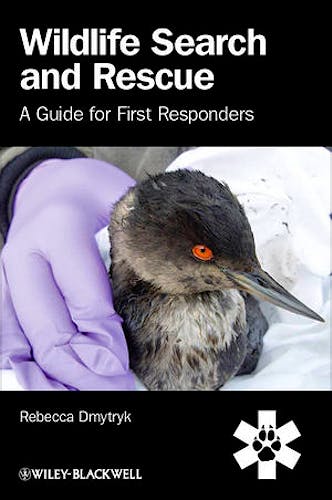

No hay productos en el carrito



Wildlife Search and Rescue. a Guide for First Responders (Softcover)
Dmytryk, R.
1ª Edición Enero 2012
Inglés
Tapa blanda
248 pags
1000 gr
null x null x null cm
ISBN 9780470655115
Editorial WILEY
LIBRO IMPRESO
-5%
64,69 €61,46 €IVA incluido
62,20 €59,10 €IVA no incluido
Recíbelo en un plazo de
2 - 3 semanas
Description
Rescuing wild animals in distress requires a unique set of skills, very different from those used in handling domestic animals. The equipment, degree of handling, the type of caging and level of care a wild animal receives can mean the difference between life and death. Wildlife Search and Rescue is a comprehensive guide on ‘best practices’ and suggested standards for response to sick, injured and orphaned wildlife. This valuable resource covers the fundamentals of wildlife rescue, from ‘phone to field’, including safe and successful capture strategies, handling and restraint techniques and initial aid. Wildlife Search and Rescue is a must have for anyone interested in knowing what to do when they are face to face with a wild animal in need, or for anyone involved in animal rescue. While the book focuses on wildlife native to North America, much of the information and many of the techniques are applicable to other species, including domestic dogs and cats.
Table of contents
- Foreword Jay Holcomb
- Preface
- Overview of wildlife rescue
- Characterizing wildlife search and rescue
- Laws and regulations governing wildlife rescue in the USA
- Code of practice
- The components of wildlife search and rescue
- Human safety
- Environmental hazards
- Human factor hazards
- Equipment hazards
- Health risks
- Zoonotic diseases
- Bacterial infections
- Fungal infections
- Viruses
- Parasites
- Personal protective equipment
- Protection from hazardous materials
- Basic safety and preparedness guidelines
- Operational risk management
- Outfitting
- The welfare of the animal
- Understanding stress
- Minimizing stress during rescue operations
- Potential for success
- The mindset of the hunter and the hunted
- The importance of natural history
- The fundamentals of the search
- The fundamentals of the capture
- Anatomy of a response team
- Overview of wildlife capture equipment
- The towel
- Herding boards
- Nets and netting
- The hoop net
- The open-ended hoop net
- The throw net
- Land seine
- Mechanical nets
- Active land seine
- The bow net and Q-net
- The whoosh net
- Driving, funnel, and walk-in traps
- The dho-gaza
- Drop traps
- Cage traps
- Projectile-powered nets
- Lures
- Catchpole
- Capture, handling, and confinement of wild birds
- Techniques for capturing wild birds
- Enticing wild birds using lures
- The Bartos trap
- Snare-type traps
- Bal-chatri
- The phai trap
- Noose carpets
- The single snare
- Leg snare pole
- Swan hook
- Pit traps
- Mist nets
- On the water
- Floating gill nets
- Floating barriers and submersible pens
- Spotlighting
- Special circumstances and particular methods
- Hummingbirds
- Loons (Gaviiformes)
- Grebes (Podicipediformes)
- Rails and coots (Rallidae)
- Brown pelican (Pelecanus occidentalis)
- Cormorants (Phalacrocoracidae)
- Waders
- Alcids
- Birds trapped in structures
- Hummingbirds in skylights
- Window strikes
- Ducklings in a pool
- Birds entangled in fishing tackle
- Rodenticide poisoning
- Shot through with a projectile
- Glue traps
- Avian botulism
- Lead poisoning
- Domoic acid poisoning (DAP)
- ‘‘Sea slime’’
- Oil and petroleum products
- Handling and restraint of wild birds
- Processing from nets and housing
- Short-term and temporary housing for wild birds
- Capture, handling, and confinement of land mammals
- Techniques for capturing wild mammals
- Chemical immobilization
- Special circumstances and particular methods
- Small rodents
- Large rodents, porcupines, beaver
- Lagomorphs, rabbits and hares
- Xenarthrans, anteaters, armadillos
- Skunks
- Canids
- Deer
- Physical restraint of land mammals
- Bats
- Small rodents
- Talpids, moles and relatives
- Squirrels
- Opossums
- Porcupines
- Lagomorphs, rabbits and hares
- Small and medium-sized carnvores
- Mustelids, badger, otter, weasels
- Skunks
- Coyotes and foxes
- Felids
- Processing mammals from nets and cages
- Temporary confinement of land mammals
- Capture and handling of reptiles and amphibians
- Marine mammal rescue
- Rescuing seals and sea lions
- Young seals and sea lions
- Hoop nets
- Modified open-ended hoop net
- Wraps, slings, and stretchers
- The towel wrap
- Flat webbing cargo net
- The floating net
- Physical restraint of seals and sea lions
- Confinement and transport of pinnipeds
- Cetaceans
- Basic wildlife first aid and stabilization
- Performing a cursory physical examination
- Bleeding
- Dehydration
- Fluid therapy
- Oral fluid administration (mammals)
- Oral fluid administration (birds)
- Subcutaneous injections
- Treating hypothermia
- Treating Hyperthermia
- Basic wound care
- Stabilizing fractures
- Robert Jones bandage
- Figure-eight wrap
- Bird body wrap
- The ball bandage
- Transporting wildlife
- Field euthanasia
- Life, liberty, and euthanasia
- Rescuing baby birds and land mammals
- Reuniting, re-nesting, and wild-fostering
- Returning altricial chicks to the wild
- Returning precocial chicks to the wild
- Returning baby mammals to the wild
- Nutritional support
- Offering public service
- Public relations and the art of shapeshifting
- Contracting with municipalities
- Appendix 1 Ready packs
- Appendix 2 Wildlife observation form
- Appendix 3 Wildlife trauma equipment and supplies
- Appendix 4 Instructions for tying nooses
- Appendix 5 Barn owl box plans and instructions
- Appendix 6 Sample contract
- Further reading
- Index
© 2026 Axón Librería S.L.
2.149.0